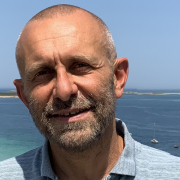
Copyright : Laboratoire LEMAR- 2018
POUVREAU Stéphane
National
Convention Ifremer-OFB
Start Date
06/04/2025
End Date
06/04/2025
In France, the flat oyster, Ostrea edulis, the only oyster native to the European coasts, a species that was once dominant in most coastal ecosystems, now survives only in a few very limited environments, particularly in Brittany (Pouvreau et al., 2021a). After several centuries of exploitation, these last cryptic populations are subject to increasing pressures that will lead to the disappearance of the species and its habitat if no targeted conservation and ecological restoration actions are taken quickly (e.g. Pogoda et al., 2019).
Ecologically, oysters are among the so-called “ecosystem engineer” species (Pouvreau et al., 2021a): they create a biogenic reef habitat favourable to the installation of other organisms, thus increasing the biodiversity of their immediate environment and providing numerous ecosystem services favourable to surrounding habitats, to the resilience of the ecosystem and ultimately useful to humans. Their conservation and restoration are part of the Nature-based Solutions allowing a better adaptation to the consequences of climate change and a better use of living resources.
In terms of conservation biology, the flat oyster has been listed since 2009 in the black list of threatened habitats and species of the OSPAR Convention (Convention for the Protection of the Marine Environment of the North-East Atlantic) and is the aim of a European Alliance created in 2019 for its restoration: the “Native Oyster Restoration Alliance” (NORA, https://noraeurope.eu). More than ten restoration projects are now underway in Europe and the first ecological restoration manuals adapted to the species are beginning to appear (zu Ermgassen et al., 2021).
In France, very recently, the FEAMP FOREVER project (2018-2020) has provided a solid foundation in the ecology of the species’ restoration (Pouvreau et al. 2021b) and has shown, against all expectations, that the suppression of certain constraints can significantly help the species’ return to the wild. The priority measure essential to this return is the implementation of biomimetic supports on the bottom that are favourable to the species, making it possible to create a restoration kickstarter that serves as an aggregation nucleus for young recruits. This type of active restoration, already used for tropical coral reefs, makes it possible to reform fairly dense colonial reef constructions, which are essential for the health of individuals, populations and the associated biodiversity.
In this context, the REEFOREST project aims to consolidate, improve and finalise the restoration methodology and to progressively implement the very first pilot restoration operations for the species on various NATURA 2000 sites that are well documented for the species, relevant for the MARHA life programme and that could be used in the future for other sectors of the French coast. The main test site of the REEFOREST project is located in the bay of Brest on the former oyster bed called “Le Roz” and the first application and validation site is located in Quiberon Bay on the former oyster bed called “Penthièvre”.
This pioneering partnership project between Ifremer and the OFB is therefore a turning point in the conservation and ecological restoration of this species in France, and also the opening of a new path in France: the restoration of marine environments and emblematic species. In the long term, the re-establishment of significant populations of flat oysters should allow a gradual return of the associated ecosystem services with potential benefits for other remarkable marine species present in the targeted sectors, including, for example, the Lithophyllum fasciculatum maerl bed at the Roz site or the eelgrass beds (Zoostera marina and noltii) at the Penthièvre site.
On a technical level, in order to successfully develop the most suitable primer for the restoration of the species, the REEFOREST project calls on various specialists in ecological materials in the marine environment (e.g. SEABOOST, BESE-elements, CorailArtefact, ESITC, PANGAEA-X…). This work is being carried out in collaboration with Ifremer, the OFB, Natura 2000 managers and professionals from the shellfish industry and the fishing industry. This pioneering work in France is also supported by environmental associations and initiatives committed to ocean preservation and ecological restoration.
References

 Cacao
Scroll to top
Cacao
Scroll to top